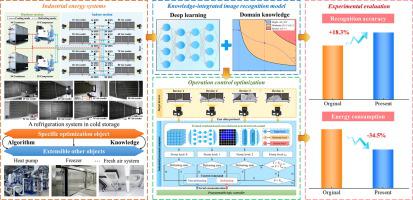Journal of Advanced Research ( IF 10.7 ) Pub Date : 2022-07-22 , DOI: 10.1016/j.jare.2022.07.003 Siliang Chen 1 , Xu Zhu 1 , Kang Chen 1 , Zexu Liu 1 , Pengcheng Li 1 , Xinbin Liang 1 , Xinqiao Jin 1 , Zhimin Du 1

|
Introduction
Image recognition technology has immense potential to be applied in industrial energy systems for energy conservation. However, the low recognition accuracy and generalization ability under actual operation conditions limit its commercial application.
Objectives
To improve the recognition accuracy and generalization ability, a novel image recognition method integrating deep learning and domain knowledge was applied to assist energy saving and emission reduction for industrial energy systems.
Methods
As a typical industrial scenario, the defrosting control in the refrigeration system was selected as the specific optimization object. By combining deep learning algorithm with domain knowledge, a residual-based convolutional neural network model (RCNN) was proposed specifically for frosty state recognition, which features the residual input and average pooling output. Based on the real-time recognition of frosty levels, a defrosting control optimization method was proposed to initiate and terminate the defrosting operation on demand.
Results
By combining the advanced image recognition technique with specific energy domain knowledge, the proposed RCNN enables both high recognition accuracy and strong generalization ability. The recognition accuracy of RCNN reached 95.06% for the trained objects and 93.67% for non-trained objects while that of only 75.86% for the conventional CNN. By adopting the presented system optimization method assisted by RCNN, the defrosting frequency, accumulated time and energy consumption were 53.8%, 57.02% and 34.5% less than the original control method. Furthermore, the environmental and cost analysis illustrated that the annual reduction in CO2 emissions is 2145.21 to 3412.84 kg and the payback time was less than 2.5 years which was far below the service life.
Conclusion
The technical feasibility and significant energy-saving benefits of deep learning-based image recognition method were demonstrated through the field experiment. Our study shows the great application potential of image recognition technology and promotes carbon neutrality in industrial energy systems.
中文翻译:

基于深度学习的宏观图像区域特征识别助力工业能源系统节能减排
介绍
图像识别技术在工业能源系统节能方面具有巨大的应用潜力。但实际运行条件下的识别准确率和泛化能力较低,限制了其商业应用。
目标
为提高识别精度和泛化能力,采用深度学习与领域知识相结合的新型图像识别方法,助力工业能源系统节能减排。
方法
作为典型的工业场景,选取制冷系统中的除霜控制作为具体的优化对象。通过将深度学习算法与领域知识相结合,提出了一种基于残差的卷积神经网络模型(RCNN),专门用于霜态识别,其特征在于残差输入和平均池化输出。基于结霜水平的实时识别,提出了一种除霜控制优化方法,以按需启动和终止除霜操作。
结果
通过将先进的图像识别技术与特定能量领域知识相结合,所提出的 RCNN 具有高识别精度和强大的泛化能力。RCNN 对训练对象的识别准确率达到 95.06%,对非训练对象的识别准确率达到 93.67%,而传统 CNN 的识别准确率仅为 75.86%。采用本文提出的RCNN辅助系统优化方法,除霜频率、累计时间和能耗比原控制方法分别降低53.8%、57.02%和34.5%。此外,环境和成本分析表明,每年可减少CO 2排放量2145.21至3412.84千克,投资回收期不到2.5年,远低于使用寿命。
结论
通过现场实验论证了基于深度学习的图像识别方法的技术可行性和显着的节能效益。我们的研究显示了图像识别技术的巨大应用潜力,并促进了工业能源系统的碳中和。



























 京公网安备 11010802027423号
京公网安备 11010802027423号